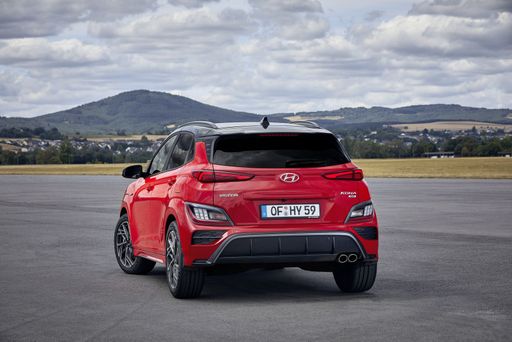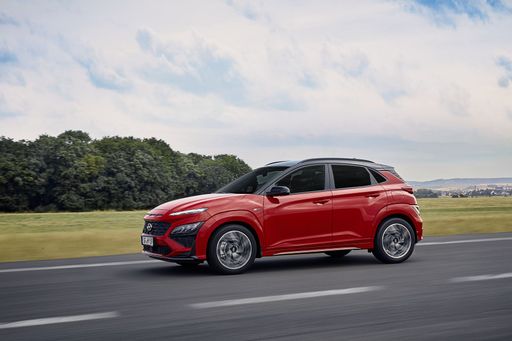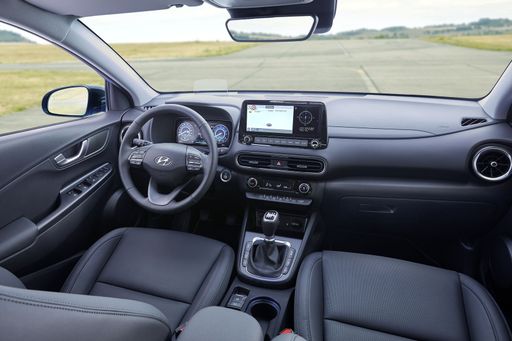Hyundai Kona vs Ferrari Purosangue – Which one offers the better deal?
Everyday use, family trips or long-distance drives – here’s where the differences show.
Discover whether Hyundai Kona or Ferrari Purosangue fits your lifestyle better.
Costs and Efficiency:
When it comes to price and running costs, the biggest differences usually appear. This is often where you see which car fits your budget better in the long run.
Hyundai Kona has a significantly advantage in terms of price – it starts at 23100 £, while the Ferrari Purosangue costs 324700 £. That’s a price difference of around 301691 £.
Fuel consumption also shows a difference: Hyundai Kona manages with 4.60 L and is therefore decisively more efficient than the Ferrari Purosangue with 17.10 L. The difference is about 12.50 L per 100 km.
Engine and Performance:
Power, torque and acceleration say a lot about how a car feels on the road. This is where you see which model delivers more driving dynamics.
When it comes to engine power, the Ferrari Purosangue has a decisively edge – offering 725 HP compared to 218 HP. That’s roughly 507 HP more horsepower.
In acceleration from 0 to 100 km/h, the Ferrari Purosangue is convincingly quicker – completing the sprint in 3.30 s, while the Hyundai Kona takes 7.80 s. That’s about 4.50 s faster.
In terms of top speed, the Ferrari Purosangue performs noticeable better – reaching 312 km/h, while the Hyundai Kona tops out at 210 km/h. The difference is around 102 km/h.
There’s also a difference in torque: Ferrari Purosangue pulls clearly stronger with 692 Nm compared to 265 Nm. That’s about 427 Nm difference.
Space and Everyday Use:
Beyond pure performance, interior space and usability matter most in daily life. This is where you see which car is more practical and versatile.
Seats: Hyundai Kona offers slightly more seating capacity – 5 vs 4.
In curb weight, Hyundai Kona is decisively lighter – 1370 kg compared to 2033 kg. The difference is around 663 kg.
In terms of boot space, the Ferrari Purosangue offers slight more room – 473 L compared to 466 L. That’s a difference of about 7 L.
Who wins the race?
The Hyundai Kona proves to be leaves the rival little chance and therefore becomes our DriveDuel Champion!
Hyundai Kona is the better all-rounder in this comparison.
 @ hyundai.news
@ hyundai.news
Hyundai Kona
Hyundai Kona
The Hyundai Kona blends a bold design with a versatile interior, making it a standout choice in the compact SUV market. Its crisp handling and responsive steering provide an engaging driving experience, whether in the city or on the open road. The vehicle also offers a range of features designed to enhance comfort and connectivity, ensuring a pleasurable journey for both driver and passengers.
details @ hyundai.news
@ hyundai.news
 @ hyundai.news
@ hyundai.news
 @ hyundai.news
@ hyundai.news
 @ hyundai.news
@ hyundai.news
Ferrari Purosangue
The Ferrari Purosangue marks the brand's first venture into the SUV segment, combining the luxury and performance synonymous with the Italian manufacturer. Its sleek design and powerful engine deliver a driving experience that is both exhilarating and refined. Inside, the Purosangue offers a sumptuous interior that perfectly balances sportiness with comfort, ensuring it stands out in the competitive luxury SUV market.
details
 @ hyundai.news
@ hyundai.news
|
|
|
|
|
Costs and Consumption |
|
|---|---|
|
Price
23100 - 41600 £
|
Price
324700 £
|
|
Consumption L/100km
4.6 - 7 L
|
Consumption L/100km
17.10 L
|
|
Consumption kWh/100km
14.6 - 16.8 kWh
|
Consumption kWh/100km
-
|
|
Electric Range
377 - 514 km
|
Electric Range
-
|
|
Battery Capacity
1.3 - 65.4 kWh
|
Battery Capacity
-
|
|
co2
0 - 163 g/km
|
co2
389 g/km
|
|
Fuel tank capacity
38 - 47 L
|
Fuel tank capacity
100 L
|
Dimensions and Body |
|
|---|---|
|
Body Type
SUV
|
Body Type
SUV
|
|
Seats
5
|
Seats
4
|
|
Doors
5
|
Doors
5
|
|
Curb weight
1370 - 1773 kg
|
Curb weight
2033 kg
|
|
Trunk capacity
466 L
|
Trunk capacity
473 L
|
|
Length
4350 - 4385 mm
|
Length
4973 mm
|
|
Width
1825 mm
|
Width
2028 mm
|
|
Height
1580 - 1585 mm
|
Height
1589 mm
|
|
Max trunk capacity
1300 L
|
Max trunk capacity
-
|
|
Payload
420 - 490 kg
|
Payload
-
|
Engine and Performance |
|
|---|---|
|
Engine Type
Electric, Petrol, Full Hybrid
|
Engine Type
Petrol
|
|
Transmission
Automatic, Manuel
|
Transmission
Automatic
|
|
Transmission Detail
Manual Gearbox, Dual-Clutch Automatic
|
Transmission Detail
Dual-Clutch Automatic
|
|
Drive Type
Front-Wheel Drive, All-Wheel Drive
|
Drive Type
All-Wheel Drive
|
|
Power HP
115 - 218 HP
|
Power HP
725 HP
|
|
Acceleration 0-100km/h
7.8 - 11.9 s
|
Acceleration 0-100km/h
3.30 s
|
|
Max Speed
162 - 210 km/h
|
Max Speed
312 km/h
|
|
Torque
200 - 265 Nm
|
Torque
692 Nm
|
|
Number of Cylinders
3 - 4
|
Number of Cylinders
12
|
|
Power kW
85 - 160 kW
|
Power kW
533 kW
|
|
Engine capacity
998 - 1598 cm3
|
Engine capacity
6496 cm3
|
General |
|
|---|---|
|
Model Year
2024 - 2025
|
Model Year
2023
|
|
CO2 Efficiency Class
A, D, C, E, F
|
CO2 Efficiency Class
G
|
|
Brand
Hyundai
|
Brand
Ferrari
|
Is the Hyundai Kona offered with different drivetrains?
Available configurations include Front-Wheel Drive or All-Wheel Drive.
The prices and data displayed are estimates based on German list prices and may vary by country. This information is not legally binding.
